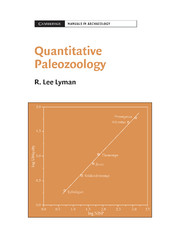Book contents
- Frontmatter
- Contents
- List of figures
- List of tables
- Preface
- 1 Tallying and Counting: Fundamentals
- 2 Estimating Taxonomic Abundances: NISP and MNI
- 3 Estimating Taxonomic Abundances: Other Methods
- 4 Sampling, Recovery, and Sample Size
- 5 Measuring the Taxonomic Structure and Composition (“Diversity”) of Faunas
- 6 Skeletal Completeness, Frequencies of Skeletal Parts, and Fragmentation
- 7 Tallying for Taphonomy: Weathering, Burning, Corrosion, and Butchering
- 8 Final Thoughts
- Glossary
- References
- Index
6 - Skeletal Completeness, Frequencies of Skeletal Parts, and Fragmentation
Published online by Cambridge University Press: 05 June 2012
- Frontmatter
- Contents
- List of figures
- List of tables
- Preface
- 1 Tallying and Counting: Fundamentals
- 2 Estimating Taxonomic Abundances: NISP and MNI
- 3 Estimating Taxonomic Abundances: Other Methods
- 4 Sampling, Recovery, and Sample Size
- 5 Measuring the Taxonomic Structure and Composition (“Diversity”) of Faunas
- 6 Skeletal Completeness, Frequencies of Skeletal Parts, and Fragmentation
- 7 Tallying for Taphonomy: Weathering, Burning, Corrosion, and Butchering
- 8 Final Thoughts
- Glossary
- References
- Index
Summary
The minimum number of individuals (MNI) is typically defined as something like “the most frequently occurring skeletal part” (Table 2.4). Variation in how that definition can be operationalized – are differences in size, age, sex, or recovery context (aggregation) considered – renders MNI as a derived measure. But on a general, in some ways less discriminating scale, how the basic definition of MNI is operationalized is simply this: Given all the remains of a taxon in a collection (how the spatiotemporal boundaries of that collection are defined need not concern us initially), redundant skeletal parts are each tallied as a single MNI. Redundant skeletal parts means that specimens overlap anatomically. Two left femora of deer overlap anatomically and are redundant with one another, just as are two upper right second molars, three right distal humeri, and four left innominates. In the order listed, the MNI values are 2, 2, 3, and 4. To reiterate, redundant – that is, anatomically overlapping – skeletal parts each represent a unique individual or a tally of one MNI.
How MNI is operationalized on a general scale – by redundant skeletal parts – forces us to recognize a previously unmentioned quantitative unit. That unit was not really distinctively named until 1982, but it had played an important role in paleozoology for decades prior to that time. Today that quantitative unit is known as the minimum number of elements, or MNE.
- Type
- Chapter
- Information
- Quantitative Paleozoology , pp. 214 - 263Publisher: Cambridge University PressPrint publication year: 2008

